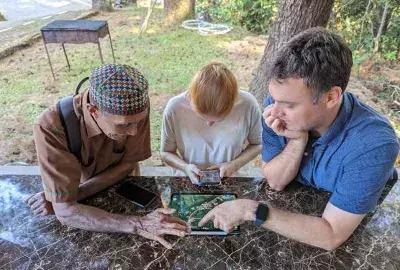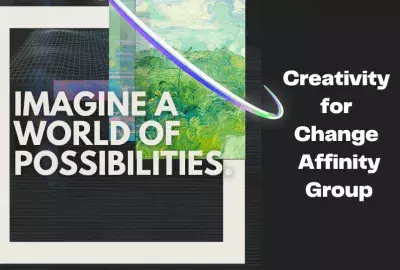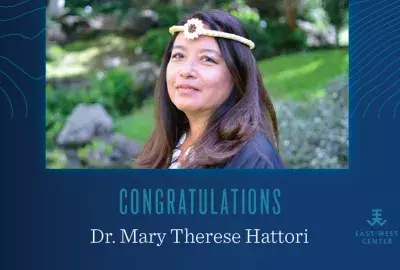Error message
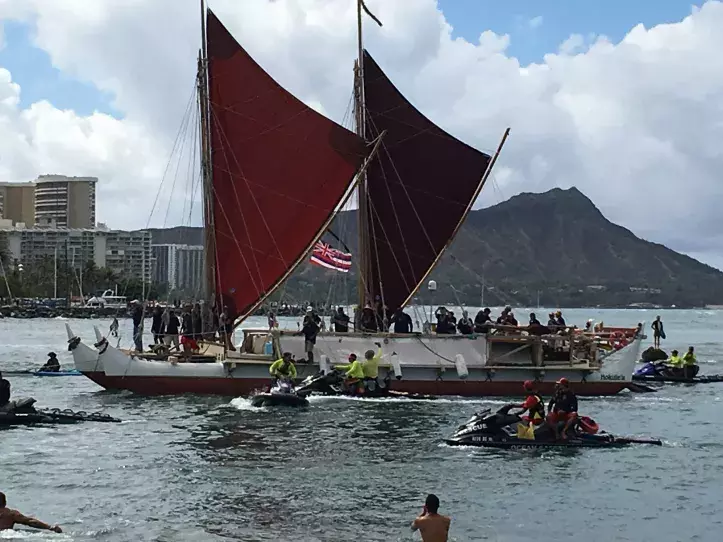
OFFICE/DEPARTMENT
After the founding of the Polynesian Voyaging Society in Hawai‘i in the early 1970s, the East-West Center provided it support as part of the Center’s mandate from the US Congress to facilitate “cultural and technical interchange between East and West.” The Center, through its deep networks in the then-UN Trust Territory of the Pacific Islands, was able to identify the traditional navigator necessary for the project, and host him in Honolulu as a “special fellow.” His name was Pius “Mau” Piailug, from the island of Satawal in what is now Yap State in the Federated States of Micronesia.
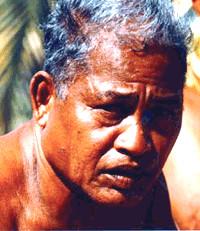
Piailug had expertise that was almost lost: mastery of the techniques of traditional navigation across vast ocean distances, relying on stars, subtle changes in the ocean currents, cloud patterns, and other data that are detectable without electronic tools.
In his book Hokule‘a: The Way to Tahiti, PVS co-founder Ben Finney recalls what was special about Piailug’s visit:
“[Mau’s fellowship at the EWC] would be a rare chance to reverse the usual direction of technical exchange programs in which technical aid flows from the US to Pacific Island nations. In this case, a Pacific Islander would be the technical expert, and the Americans would be the recipients of foreign aid.”
Finney, a University of Hawai‘i anthropologist and East-West Center researcher, along with David Lewis, an East-West Center senior fellow, and several others were eager to prove a theory: that ancient Islanders had the skills and knowledge to sail great distances on a course across the Pacific Ocean. According to a 1976 East-West Center Magazine, the Center provided fellowships and other support for a team assembled by Finney and Lewis (who was a physician for the voyage and a researcher of traditional navigation). In addition to Mau, the fellowships went to Herb Kawainui Kane, renowned artist and expert on Hawaiian culture, co-designer and builder of the Hōkūle‘a, a replica of a traditional Polynesian voyaging canoe; Rodo Tuko Williams, a veteran sea captain from Tahiti; and Kimo Hugho, a member of the PVS board of directors and a Honolulu fireman and veteran canoe racer who trained crew for and crewed on the voyage.
In May 1976, the Hōkūle‘a, set sail from Hawai‘i for Tahiti with Piailug as navigator. Thirty-three days later, the canoe landed in Pape‘ete.
It had been more than 600 years since canoes had made the journey along the ancestral Polynesian sea route. Mau would go on to pass the oral traditions of navigation to Polynesian Voyaging Society leaders such as current PVS President Nainoa Thompson, who in turn would transmit the knowledge to others. The Hōkūleʻa launched a renaissance of voyaging, canoe building, and non-instrument navigation that now extends across Polynesia and the entire Pacific.
“The cultural significance of the voyage, along with the scientific nature of experiments involved makes it a natural concern of the Center. It is multi-national, multi-cultural, and multi-disciplinary. And it involves extensive institutional and community cooperation. All these add up to increased cultural understanding, and that’s what we’re all about.”
--EWC Vice President John Brownell in 1976
The East-West Center and the Polynesian Voyaging Society continue to have an enduring relationship, exemplified in 2015 when the Center awarded Nainoa Thompson its Asia Pacific Community Building Award. In addition, the PVS is an important contributor to numerous Center programs, including the Pacific Islands Conference of Leaders, Future Leaders of the Pacific, Pacific Islands Leadership Program with Taiwan, and Asia Pacific Leadership Program. These programs help develop leaders with both regional and international perspectives and the ability to “navigate change”—necessary components of effective contemporary leadership.
After the founding of the Polynesian Voyaging Society in Hawai‘i in the early 1970s, the East-West Center provided it support as part of the Center’s mandate from the US Congress to facilitate “cultural and technical interchange between East and West.” The Center, through its deep networks in the then-UN Trust Territory of the Pacific Islands, was able to identify the traditional navigator necessary for the project, and host him in Honolulu as a “special fellow.” His name was Pius “Mau” Piailug, from the island of Satawal in what is now Yap State in the Federated States of Micronesia.

Piailug had expertise that was almost lost: mastery of the techniques of traditional navigation across vast ocean distances, relying on stars, subtle changes in the ocean currents, cloud patterns, and other data that are detectable without electronic tools.
In his book Hokule‘a: The Way to Tahiti, PVS co-founder Ben Finney recalls what was special about Piailug’s visit:
“[Mau’s fellowship at the EWC] would be a rare chance to reverse the usual direction of technical exchange programs in which technical aid flows from the US to Pacific Island nations. In this case, a Pacific Islander would be the technical expert, and the Americans would be the recipients of foreign aid.”
Finney, a University of Hawai‘i anthropologist and East-West Center researcher, along with David Lewis, an East-West Center senior fellow, and several others were eager to prove a theory: that ancient Islanders had the skills and knowledge to sail great distances on a course across the Pacific Ocean. According to a 1976 East-West Center Magazine, the Center provided fellowships and other support for a team assembled by Finney and Lewis (who was a physician for the voyage and a researcher of traditional navigation). In addition to Mau, the fellowships went to Herb Kawainui Kane, renowned artist and expert on Hawaiian culture, co-designer and builder of the Hōkūle‘a, a replica of a traditional Polynesian voyaging canoe; Rodo Tuko Williams, a veteran sea captain from Tahiti; and Kimo Hugho, a member of the PVS board of directors and a Honolulu fireman and veteran canoe racer who trained crew for and crewed on the voyage.
In May 1976, the Hōkūle‘a, set sail from Hawai‘i for Tahiti with Piailug as navigator. Thirty-three days later, the canoe landed in Pape‘ete.
It had been more than 600 years since canoes had made the journey along the ancestral Polynesian sea route. Mau would go on to pass the oral traditions of navigation to Polynesian Voyaging Society leaders such as current PVS President Nainoa Thompson, who in turn would transmit the knowledge to others. The Hōkūleʻa launched a renaissance of voyaging, canoe building, and non-instrument navigation that now extends across Polynesia and the entire Pacific.
“The cultural significance of the voyage, along with the scientific nature of experiments involved makes it a natural concern of the Center. It is multi-national, multi-cultural, and multi-disciplinary. And it involves extensive institutional and community cooperation. All these add up to increased cultural understanding, and that’s what we’re all about.”
--EWC Vice President John Brownell in 1976
The East-West Center and the Polynesian Voyaging Society continue to have an enduring relationship, exemplified in 2015 when the Center awarded Nainoa Thompson its Asia Pacific Community Building Award. In addition, the PVS is an important contributor to numerous Center programs, including the Pacific Islands Conference of Leaders, Future Leaders of the Pacific, Pacific Islands Leadership Program with Taiwan, and Asia Pacific Leadership Program. These programs help develop leaders with both regional and international perspectives and the ability to “navigate change”—necessary components of effective contemporary leadership.





